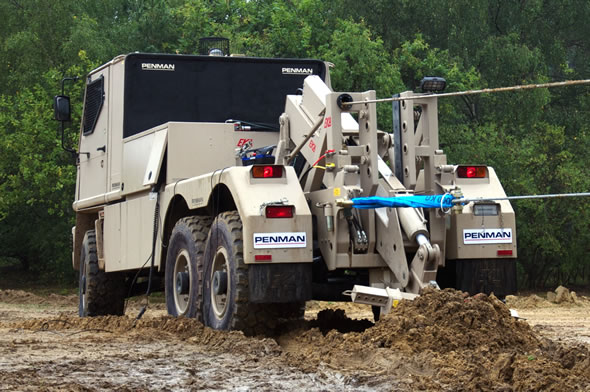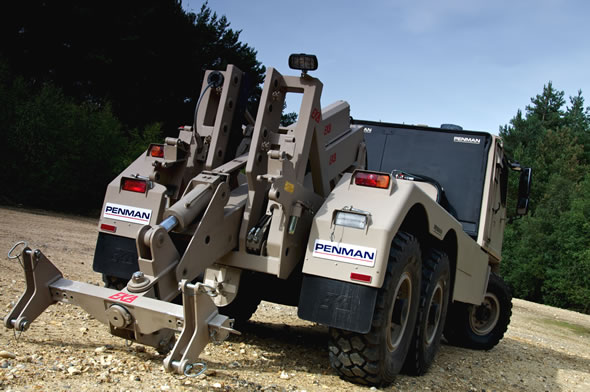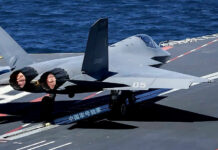
The new family of light protected patrol vehicles soon to be inducted in service will require new support systems, particularly recovery systems enhancing the mobility and self recovery of such vehicles, and recovery vehicles capable of moving and operating in confined urban spaces where the LPPV will typically operate. Two british companies addressing these requirements debut such systems at DSEi 2011.
The Lightweight Recovery Vehicle (LRV) making its international market debut at DSEi 2011 was developed by Penman-EKA, a newly formed joint venture between recovery vehicle specialist EKA, and Penman.

The new vehicle was designed as a powerful yet manoeuvrable recovery platform designed to support the new class of protected lightweight vehicles. These small, protected vehicles may require rescue from narrow and confined locations such as village streets – where heavier, full-width recovery vehicles cannot penetrate. The first LRV vehicle to be built is based on the DURO 3 6×6 re-roled logistics chassis from General Dynamics Europe, forming a compact, 2.16 metre width LRV. It incorporates key elements from the EKA SuperCompact system incorporated with the fleet of Support Vehicle (Recovery), currently in service with the UK MoD, thereby reducing and simplifying logistics support. According to the developers, the concept has been designed for application and integration with other suitable vehicle platforms.
The EKA recovery equipment is integrated onto a specialist ‘skid’ built by Penman, which closely matches the operational requirements for both recovery and automotive performance. In operation, the new unit is effectively similar to a downscaled version of the larger SuperCompact equipment.
The recovery boom assembly comprises a telescopic rectangular section, the inner box of which carries the recovery bar assembly. The boom provides a maximum lift rating of 6 tonnes and a maximum casualty vehicle weight capability of 15 tonnes. An 8 tonne constant-pull capstan winch is fitted and, in order to anchor the vehicle when winching to the rear, two 8 tonne rated anchor spades are provided to enable two-part pulls to be carried out.
Safe stand-off remote operation of the recovery system is controlled from a chest pack with a 10 metre umbilical, connected to a frame mounted control box on the vehicle. The chest pack features graduable paddle joysticks (suitable for gloved operation) for boom in/out, boom up/down and recovery bar levelling.
Apart from the specialist ‘skid’ onto which the recovery system is integrated, Penman has upgraded and modified the vehicle platform to meet anticipated operational requirements. An additional cab seat is provided within the fully armoured tilt cab – as are riot grilles and a cab escape facility. Up-rated heavy duty springs, shock absorbers and off-road tyres have been added to further enhance the vehicle’s all-terrain performance. Other features include full fitment for current in-service ECM and EECM, including power provision and cooling.

Multimount winch system offers self-recovery solution for new or legacy fleet

Enhancing the mobility of military vehicles can also utilise self-recovery capability, employing powered winch systems. A typical system developed by Oldbury UK uses a patented Multimount system developed for the next generation of protected and soft-skin vehicles. The system comprises front and rear winch ‘carriers’, integrated onto the platform, utilising the vehicle’s existing lifting / recovery eyes and standard towing pintle and jaw. The winch itself can be mounted quickly and simply fitted or released, without using special tools. The system accommodates commonly available winches. The use of a single winch covering both front and rear self-recovery requirements reduces both payload and on-board inventory. The unit can be lifted and installed by two persons.
















